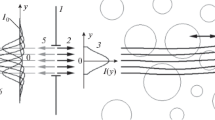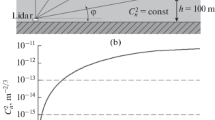Abstract
Two designs of a laser radar system based on the backscatter amplification effect (BSA) are suggested. The system is a micropulse aerosol lidar with two receiving channels, one of which records an increase in the lidar returns at the laser beam axis as the atmospheric turbulence intensifies. The second channel does not respond to the BSA and is required for calibration. The BSA effect manifests itself in a narrow spatial region around the laser beam axis; so, the receiver aperture should be small enough and comparable with the Fresnel zone. The creation of the turbulent lidar became possible with the advent of compact diode-pumped micropulsed lasers with high pulse repetition rates. The lidar is intended for continuous long-term unattended operation. It is eye-safe. Two designs of the turbulent lidar based on an afocal Mersenne telescope (mirror collimator) are suggested. BSA-2 and BSA-3 turbulent lidars are described. An algorithm is suggested for retrieval of the structure parameter of optical turbulence C 2 n from lidar data based on the Vorob’ev’s approximation for a statistically homogeneous turbulent medium.
Similar content being viewed by others
References
A. G. Vinogradov, Yu. A. Kravtsov, and V. I. Tatarskii, “The effect of intensification of back scattering by bodies that are situated in a medium having random inhomogeneities,” Radiophys. Quantum Electron. 16 (7), 818–823 (1973).
A. G. Vinogradov, A. S. Gurvich, S. S. Kashkarov, Yu. A. Kravtsov, and V. I. Tatarskii, USSR Patent No. 359, Bull. Izobret., No. 21 (1989).
V. A. Banakh and I. N. Smalikho, “Determination of optical turbulence intensity by atmospheric backscattering of laser radiation,” Atmos. Ocean. Opt. 24 (5), 457–465 (2011).
I. N. Smalikho, “Calculation of the backscatter amplification coefficient of laser radiation propagating in a turbulent atmosphere using numerical simulation,” Atmos. Ocean. Opt. 26 (2), 135–139 (2013).
V. A. Banakh, “Enhancement of the laser return mean power at the strong optical scintillation regime in a turbulent atmosphere,” Atmos. Ocean. Opt. 26 (2), 90–95 (2013).
V. V. Vorob’ev and A. G. Vinogradov, “Effect of background turbulence in lidar investigations of clear air turbulence,” Atmos. Ocean. Opt. 27 (2), 134–141 (2014).
V. V. Vorob’ev, “On the applicability of asymptotic formulas of retrieving “optical” turbulence parameters from pulse lidar sounding data: I—Equations,” Atmos. Ocean. Opt. 30 (2), 156–161 (2017).
A. S. Gurvich, “Lidar sounding of turbulence based on the backscatter enhancement effect,” Izv., Atmos. Ocean. Phys. 48 (6), 585–594 (2012).
A. S. Gurvich, “Lidar positioning of higher clear-air turbulence regions,” Izv., Atmos. Ocean. Phys. 50 (2), 143–151 (2014).
A. S. Gurvich, RF Patent No. 116245, Bull. Izobret., No. 14 (May 20, 2012).
I. A. Razenkov, V. A. Banakh, and A. I. Nadeev, RF Patent No. 153460, Bull. Izobret., No. 20 (July 20, 2015).
I. A. Razenkov, “Aerosol lidar for continuous atmospheric monitoring,” Atmos. Ocean. Opt. 26 (4), 308–319 (2013).
V. A. Banakh, I. A. Razenkov, and I. N. Smalikho, “Aerosol lidar for study of the backscatter amplification in the atmosphere. Part I. Computer simulation,” Opt. Atmos. Okeana 28 (1), 5–11 (2015).
V. A. Banakh, I. A. Razenkov, and I. N. Smalikho, “Laser echo signal amplification in a turbulent atmosphere,” Appl. Opt. 54 (24), 7301–7307 (2015).
V. A. Banakh and I. A. Razenkov, “Aerosol lidar for study of the backscatter amplification in the atmosphere. Part II. Construction and experiment,” Opt. Atmos. Okeana 28 (2), 113–119 (2015).
https://doi.org/www.zemax.com. Cited April 11, 2017.
Author information
Authors and Affiliations
Corresponding author
Additional information
Original Russian Text © I.A. Razenkov, 2018, published in Optika Atmosfery i Okeana.
Rights and permissions
About this article
Cite this article
Razenkov, I.A. Turbulent Lidar: I−Design. Atmos Ocean Opt 31, 273–280 (2018). https://doi.org/10.1134/S1024856018030119
Received:
Published:
Issue Date:
DOI: https://doi.org/10.1134/S1024856018030119




